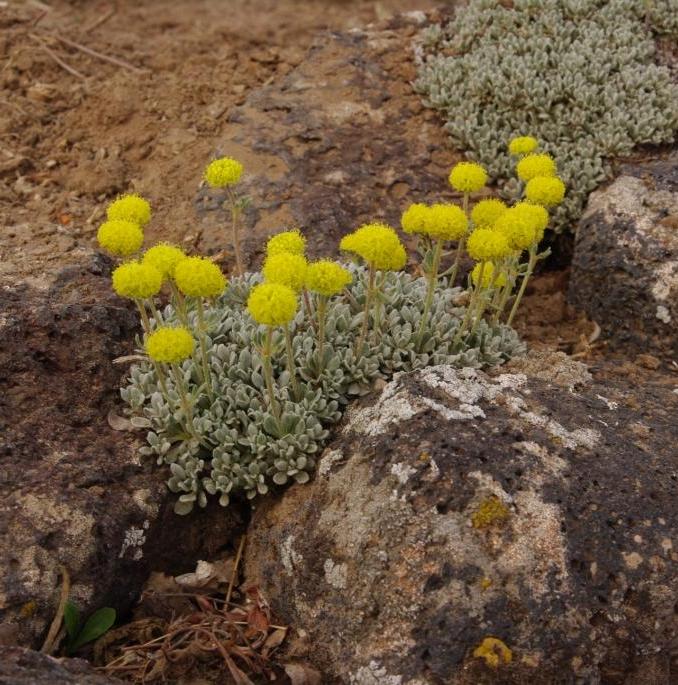Douglas Buckwheat in the Landscape

Stephen Love, University of Idaho
Scientfic Name: Eriogonum douglasiiCommon Name: Douglas Buckwheat
Description: Douglas buckwheat is a considered a shrublet because it has evergreen leaves and woody stems. Plants form dense mats, and the foliage is seldom over 4 inches tall. The leaves are covered with short hairs, giving them a silver-gray to sometimes white color. Single clusters of bright yellow flowers, often tinged red, grow like pom-poms at the end of short flower stalks (to 8 inches tall). Bloom occurs May to July but is often followed by a second flush of bloom in late summer. High levels of drought tolerance and unique appearance make Douglas buckwheat a great subject for a xeric bed, border or rock garden.
Native Habitat: Eriogonum douglasii is native to the dry mountains of central Washington and Oregon, and to northern California. Plants grow on dry hillsides with sagebrush and ponderosa pine at elevations ranging from 3,600 to 8,000 feet.
Cultural Requirement
Soil: Prefers a neutral to alkaline, nutrient-poor, well-drained soil. Tolerates clay soils if not over-watered.
Moisture Tolerance: Xeric conditions or with limited supplemental water if conditions become extremely dry.
Sun/Shade/Preference: Requires full sun.
Transplanting: Tolerates transplanting well, both from pot to pot and from pot to garden. Plants develop slowly and can be difficult to maintain in pots for a long period of time.
Propagation: Easy to grow from seed. Benefits from a 2 to 4 week cold stratification period. Usually germinates in large numbers. Seedlings are prone to damping off and require careful watering. Allow plants to develop 5 to 6 true leaves before transplanting. Large plants will not survive handling as bare root stock.
Maintenance (pruning, fertilization, deadheading, division, irrigation, etc): Minimal maintenance is required. Remove spent flower stems to improve appearance. Apply supplemental irrigation if the leaves begin to show signs of stress. Limited or no fertilization is needed once plants are established.
Insect, disease, or other problems: Douglas buckwheat has no significant insect or disease problems.
Landscape Value
Use in the Landscape: Douglas buckwheat provides attractive foliage and flowers in xeric landscapes and complements other low-water plants. Makes an excellent rock garden accent and also works well in mounded beds or low border plantings. Effective in naturalized designs but a tidy form makes it useful in water-conserving formal designs.
Weediness/Invasive Potential: Douglas buckwheat has no aggressive or weedy characteristics. In is not rhizomatous and the occasional volunteer seedling is easily removed.
Foliage: The silver or silver-gray foliage forms a dense, attractive mat. The leaves are elliptical to round with dense hairs on both the upper and lower surfaces. Foliage is evergreen and attractive in early spring.
Flower: The flowering stems are stiffly upright with small, bract-like leaves at mid-stem. The tiny, bright yellow flowers grow in solitary capitate clusters at the top of the stems. As the flowers age, they often take on a reddish hue.
Timing: May-July
Fruit: Inconspicuous achenes shaped like tear drops are enclosed in a dried perianth (old petals). Each tiny flower produces a single seed.
Form: A flattened mat before and after flowering. Short-upright when in bloom.
Texture: Moderately fine.
Ultimate Size: Pre- and post-bloom plants are typically 3-4 inches tall and up to a foot wide. In flower the plants are 5 to 8 inches tall.
Rate of Growth: Douglas buckwheat plants grow slowly through all stages of life. They seldom bloom the first year after transplanting to the garden.
Suggested Plant Partners: Plant Douglas buckwheat with other small- to medium-sized xeric plants. Good partners include Salvia dorrii, Artemisia frigida, Linum lewisii, Oenothera caespitosa, Calylophus lavandulifolius, and Erigeron compositus. It also complements small native grasses such as Poa secunda, Sporobolus airoides, or Bouteloua gracilis.
Availability: Very limited availability as potted plants. Seed can occasionally be purchased from the Eriogonum Society or from native plant seed suppliers.
Cultivars: None.
References:

